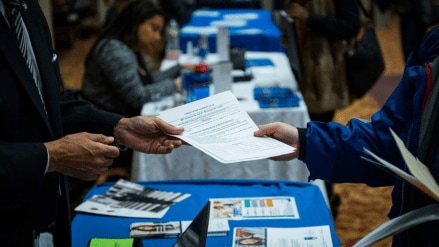Amid mass layoffs, AI replacing jobs, and an immigration crackdown, the US job market is entering the “Great Freeze.” If you’re not familiar with the term, it refers to a situation where companies aren’t firing employees, but they’re also not hiring much. For workers, this means career growth is stalling, while job seekers face limited opportunities.
Low layoffs, low hiring hit US job market
The US job market is currently experiencing a mix of highs and lows. On the positive side, layoffs and unemployment remain low, meaning fewer people are losing their jobs. This trend has continued for over a year. But the bad news is that the number of job openings and new hires has also dropped. While people aren’t being fired, there are now limited opportunities for career growth or for job seekers to find new positions.
Economists say that even though the US economy is strong, companies are avoiding big layoffs and are cautious about hiring due to uncertainties like tariffs and other risks, and this is keeping the labour market stuck. “We’re seeing employers and job seekers both trying to wait out any of the uncertainty,” Nicole Bachaud, labour economist at ZipRecruiter, told Business Insider.
The survey carried out by ZipRecruiter reveals that employee turnover has fallen dramatically, from 177% in 2023 to just 50% in 2025. For the past couple of years, both workers and businesses have preferred stability over change.
Economic uncertainty has led many businesses to hold onto existing staff, a behaviour sometimes called “job hugging.” In 2025, 30% of employers reported lower turnover due to external economic factors, up from 24% in 2024.
The survey also revealed that 76% of employers are interested in keeping staff a key focus in the year ahead. At the same time, opportunities for entry-level workers are likely to improve, with 32% of companies planning to hire more for these roles than any other level.
Why the freeze may last
Experts warn that the current labour market conditions aren’t likely to change soon. Daniel Zhao, chief economist at Glassdoor, explained, “We’re only a few months from the end of the year, and there isn’t an immediately obvious reason why the job market would suddenly snap out of the malaise it’s in.”
Companies are hesitating to make big moves because growth and consumer spending remain solid. Jason Draho from UBS Global Wealth Management said that earnings are positive and businesses are still profitable. Stephen Juneau, senior economist at Bank of America, told Business Insider, “Earnings are still positive, businesses are still making money, and there’s not really a catalyst for them to reevaluate their head count.”
However, signs of change have started showing. Nearly two-thirds of employers (63%) plan to increase hiring in the coming year, particularly for entry-level roles that were most impacted during the slow period. “The organisations that adapt to new technologies, prioritise skills, and invest in their workforce will gain a competitive edge in securing top talent as the market shifts,” said Bachaud in a report released on October 21.
According to Business Insider, in August, there were 7.4 million unemployed people but only 7.2 million job openings, a significant slowdown compared to the post-pandemic labour market recovery.
Workers often have to settle for positions that may not match their experience, pay expectations, or skill sets. Low turnover also makes it harder for employees to advance internally. “Many workers have to settle for jobs that are not a good fit for them, whether they don’t pay commensurate with their experience or it’s not in a field or industry that they’re skills would best match,” Zhao told Business Insider.
